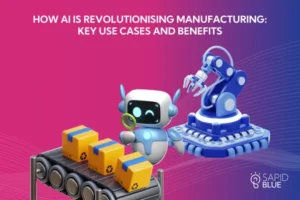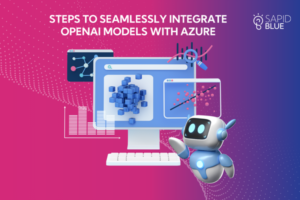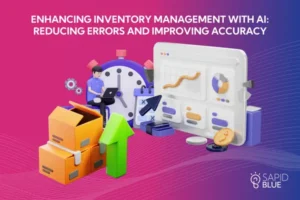In today’s fast-changing business world, using Artificial Intelligence (AI) isn’t just a fancy idea anymore. It’s become essential for smart planning and smooth operations. AI isn’t just about using new tech to look cool. It’s about making things easier, making better decisions, and making your business grow faster and work better. So, it’s crucial to bring AI into your business to not just survive but thrive in the digital age.
AI is becoming super important in business. It helps do routine tasks automatically and find useful insights in big piles of data. In every sector, from healthcare to finance, and from retail to manufacturing, AI is making things more innovative, efficient, and satisfying for customers.
But getting AI into your business isn’t easy. It needs careful planning, understanding your current processes, and knowing what you want to achieve. It’s not just about buying the latest AI gadgets; it’s about fitting these solutions into your company’s goals, culture, and what your customers want. So, the real challenge isn’t getting AI; it’s using it well to make better decisions, work smarter, and stay ahead of the competition.
As we dig deeper into using AI, we see it’s a big job involving planning, getting everyone involved, and keeping improving. This blog aims to guide you through integrating AI into your business step by step. It covers everything from figuring out what your business needs, choosing the right AI tools, preparing your data, planning how to use AI, and checking if it’s working well. Whether you’re just starting with AI or want to make your current AI better, this guide will give you the tips and strategies to make the most of AI for your business.
1. Understanding AI Integration
a) Defining AI Integration and Its Relevance to Business Operations
AI integration refers to the strategic embedding of AI technologies into various facets of business operations to automate processes, enhance decision-making, and deliver personalized customer experiences. It encompasses the use of machine learning algorithms, natural language processing, robotics, and other AI technologies to analyze vast datasets, predict outcomes, and make intelligent decisions.
The relevance of AI integration in business operations cannot be overstated. In an era where data is king, AI’s ability to efficiently process and analyze information sets the stage for more informed decision-making and strategic planning. From automating mundane tasks to providing deeper insights into customer behavior, AI for business is a game-changer that can significantly enhance operational efficiency and drive growth.
b) Exploring the Benefits of AI Integration
The application of AI in business comes with a plethora of benefits that can revolutionize how operations are conducted. Here are some of the key advantages:
- Improved Decision-Making: AI algorithms can process and analyze data at a speed and accuracy that humans cannot match, leading to faster and more informed decisions.
- Cost Reduction: By automating routine tasks, AI helps in reducing operational costs and allows human resources to focus on more strategic tasks that require human intelligence.
- Enhanced Productivity: AI-powered tools and solutions streamline operations, reduce errors, and increase output, thereby boosting overall productivity.
c) Discussing Common Misconceptions and Challenges Associated with AI Integration
While the advantages of integrating AI into business operations are clear, several misconceptions and challenges can hinder its adoption:
- Misconception: AI is Primarily for Tech Giants: One common myth is that AI is only suitable for large tech companies. However, AI for business is scalable and can be tailored to benefit small and medium-sized enterprises as well.
- Misconception: AI Will Lead to Massive Job Losses: Another fear is that AI will automate jobs, leading to widespread unemployment. While AI does automate some tasks, it also creates new opportunities and roles that require human oversight and intervention.
- Challenge: Data Privacy and Security: With the increased use of AI, businesses must navigate the complexities of data privacy and ensure robust security measures to protect sensitive information.
- Challenge: Integration and Scalability: Integrating AI into existing systems can be complex, and businesses must choose scalable AI solutions that can grow with their operations.
2. Assessing Business Needs and Objectives
In the journey of integrating Artificial Intelligence (AI) into business operations, understanding the unique needs and objectives of your business stands paramount. The application of AI in business isn’t a one-size-fits-all solution; it requires a meticulous approach to identify the specific areas where AI can bring about transformative changes. Here’s how businesses can navigate through this crucial phase:
a) Conducting a Comprehensive Assessment of Existing Business Processes
Before embarking on the AI integration journey, it’s essential to take a step back and thoroughly evaluate your current business processes. This evaluation involves mapping out each process, identifying bottlenecks, inefficiencies, or areas that could benefit from automation and enhanced decision-making capabilities. The goal here is to pinpoint precise functions where the application of AI can deliver substantial value, be it in enhancing customer service through chatbots, streamlining supply chain management, or automating repetitive administrative tasks. Such a targeted approach not only ensures a smoother integration of AI technologies but also helps in achieving quick wins that can boost stakeholder confidence.
b) Defining Clear Objectives and Key Performance Indicators (KPIs) for AI Integration Projects
With a clear understanding of where AI can be most beneficial, the next step is to define explicit objectives for your AI integration projects. These objectives should be SMART: Specific, Measurable, Achievable, Relevant, and Time-bound. Equally important is establishing Key Performance Indicators (KPIs) that will serve as benchmarks to measure the success of your AI initiatives. Whether it’s improving customer satisfaction scores, reducing operational costs, or achieving a certain level of sales through AI-powered recommendations, setting clear KPIs will help in quantifying the impact of AI on your business operations.
c) Highlighting the Importance of Aligning AI Initiatives with Broader Business Goals
For AI for business to yield lasting benefits, it’s crucial that AI initiatives are not viewed in isolation but are deeply integrated with the broader business goals. This alignment ensures that AI solutions contribute positively towards the overarching objectives of the organization, whether it’s market expansion, revenue growth, innovation, or customer experience enhancement. Leaders must foster a culture where AI is seen as a strategic enabler rather than a standalone solution. By doing so, businesses can ensure that their AI investments are driving them closer to their long-term visions, fostering an environment of continuous improvement and innovation.
3. Choosing the Right AI Solutions

The rapid advancements in artificial intelligence (AI) have paved the way for transformative changes across various industries, making the application of AI in business not just a trend but a necessity for staying competitive. When it comes to integrating AI into your business operations, the key to success lies in selecting the right AI solutions that align with your business objectives and operational frameworks. This segment explores the critical factors in evaluating and choosing the most suitable AI technologies, focusing on machine learning, natural language processing, and computer vision, among others, and how they can be leveraged for business.
a) Evaluating Different Types of AI Solutions
The first step in harnessing the power of AI for business is to understand the different types of AI solutions available in the market and how they can address specific business needs.
- Machine Learning (ML): ML algorithms can analyze vast amounts of data to identify patterns and make predictions, making it ideal for applications like demand forecasting, customer segmentation, and fraud detection.
- Natural Language Processing (NLP): NLP technologies enable machines to understand and interpret human language, opening avenues for enhanced customer service through chatbots, sentiment analysis, and automated report generation.
- Computer Vision: This AI technology allows machines to interpret and make decisions based on visual data. Retail businesses can use computer vision for inventory management, while manufacturing units can employ it for quality control.
b) Assessing Scalability, Compatibility, and Reliability
Once you have a grasp of the various AI technologies, the next critical step is to assess their scalability, compatibility, and reliability to meet your specific business requirements.
- Scalability: Choose AI solutions that can grow with your business. Scalable AI solutions can handle increasing amounts of work or can be easily upgraded to enhance their capacity.
- Compatibility: The AI solution should seamlessly integrate with your existing IT infrastructure and business processes without requiring extensive modifications.
- Reliability: Opt for AI solutions known for their reliability and minimal downtime, as any disruption can significantly impact your business operations.
c) Considering Cost, Implementation Complexity, and Potential ROI
Implementing AI in business operations is an investment that should be carefully evaluated to ensure it brings value to the organization.
- Cost: Beyond the initial acquisition cost, consider the total cost of ownership, which includes implementation, maintenance, and any necessary upgrades.
- Implementation Complexity: Evaluate whether the AI solution can be easily integrated into your current systems or if it requires a complete overhaul of your existing processes.
- Potential ROI: Project the potential return on investment by analyzing how the AI solution can improve operational efficiency, reduce costs, or increase revenue. Solutions that offer clear and measurable ROI should be prioritized.
4. Data Preparation and Infrastructure
The backbone of successfully implementing Artificial Intelligence (AI) in business operations is the meticulous preparation of data and the robustness of the supporting infrastructure. As we delve into the transformative application of AI in business, it becomes evident that the quality, consistency, and security of data, coupled with a solid infrastructure, are pivotal. These elements ensure that AI technologies not only integrate seamlessly but also deliver on their promise of enhancing business efficiency and innovation.

a) The Critical Role of Data in AI Integration
At the heart of AI’s application in business is data. The adage “Garbage in, garbage out” couldn’t be more relevant when it comes to AI. High-quality, consistent data is the fuel that powers AI algorithms, enabling them to generate accurate, actionable insights. AI for business relies on vast amounts of data to learn and make intelligent decisions. However, the data must be meticulously cleaned, categorized, and normalized to ensure that AI systems function optimally. Data anomalies, inconsistencies, or inaccuracies can lead to flawed insights, making it imperative for businesses to invest in rigorous data preparation processes. This step ensures that the AI solutions are not only effective but also reliable in their application across various business functions.
b) Addressing Data Privacy and Security Concerns
With the integration of AI into business operations comes the heightened responsibility of managing data privacy and security. The application of AI in business necessitates the collection, processing, and storage of vast amounts of data, raising significant concerns over data protection. Businesses must adhere to stringent data privacy laws and regulations, such as GDPR in Europe and the IT Act in India, to protect sensitive information from breaches and unauthorized access. Implementing robust data encryption, access controls, and regular security audits becomes non-negotiable to safeguard data integrity and maintain customer trust. Furthermore, AI models themselves must be designed with privacy in mind, ensuring that they operate transparently and ethically.
c) Infrastructure Requirements for Deploying AI Solutions
Deploying AI solutions extends beyond software to encompass a comprehensive infrastructure setup, including the necessary hardware and cloud services. The infrastructure must be capable of supporting the heavy computational demands of AI algorithms and the storage needs of large datasets. This involves investing in high-performance computing systems, GPUs, and scalable storage solutions. Additionally, cloud services offer flexible, cost-effective options for businesses to deploy AI solutions without the need for extensive on-premise infrastructure. These cloud platforms provide the added benefits of scalability, reliability, and access to advanced AI tools and services. Choosing the right combination of hardware, software, and cloud services is crucial to ensure the seamless integration and optimal performance of AI within business operations.
5. Implementation Strategies
Integrating Artificial Intelligence (AI) into business operations has become more than just a trend; it’s a strategic necessity for companies looking to stay ahead in the digital age. The application of AI in business spans across various domains, enhancing efficiency, decision-making, and overall productivity. However, the journey toward a successful AI implementation requires meticulous planning and a strategic approach. Below, we delve into the nuances of different implementation strategies, best practices for managing organizational change, and the critical role of continuous monitoring and refinement of AI systems.
a) Phased Deployment: A Step-by-Step Approach to AI Integration
One of the most effective strategies for integrating AI into business operations is phased deployment. This approach allows businesses to gradually implement AI solutions, starting with smaller, manageable projects before expanding to more complex applications. Phased deployment minimizes risk by providing ample opportunity to address challenges and refine strategies at each stage. It enables the organization to assess the impact of AI on business processes and make necessary adjustments, ensuring a smoother transition and higher success rate.
b) Pilot Projects: Testing the Waters with AI for Business
Pilot projects serve as the testing ground for AI initiatives, offering invaluable insights into the practical application of AI in business. By selecting a specific area or process for the pilot, businesses can closely monitor the performance and impact of AI solutions in a controlled environment. This focused approach allows for a comprehensive analysis of potential benefits, challenges, and ROI, informing the decision-making process for wider implementation. Pilot projects also play a crucial role in demonstrating the value of AI to stakeholders, garnering support for further investment in AI technologies.
c) Full-Scale Integration: Unleashing the Full Potential of AI
After successful phased deployments and pilot projects, businesses may opt for full-scale integration of AI solutions. This step signifies the organization’s commitment to leveraging AI for business transformation. Full-scale integration involves a comprehensive application of AI across multiple business functions, driving innovation, efficiency, and competitive advantage. However, this stage requires careful planning, substantial investment in technology and talent, and a commitment to fostering an AI-centric culture within the organization.
d) Best Practices for Managing Change and Overcoming Resistance
The implementation of AI in business operations often encounters resistance, stemming from fear of the unknown, perceived threats to job security, and the challenge of adapting to new ways of working. To overcome this resistance, it’s essential to employ effective change management practices, such as:
- Clear Communication: Transparently communicating the purpose, benefits, and expected outcomes of AI initiatives can help alleviate fears and build trust among employees.
- Employee Involvement: Engaging employees in the planning and implementation process encourages buy-in and helps identify potential advocates for AI within the organization.
- Training and Upskilling: Providing opportunities for employees to develop new skills relevant to an AI-driven workplace ensures they feel valued and secure in their roles.
e) Continuous Monitoring, Evaluation, and Refinement
The journey doesn’t end with the deployment of AI solutions. Continuous monitoring and evaluation are critical to understanding the effectiveness of AI applications in real-world scenarios. By regularly assessing performance against predefined metrics, businesses can identify areas for improvement, adjust strategies, and ensure that AI initiatives continue to deliver value. Moreover, the iterative refinement of AI systems in response to feedback and changing business needs ensures that organizations remain agile and innovative in leveraging AI for business success.
6. Training and Talent Development
In the dynamic landscape of business technologies, Artificial Intelligence (AI) emerges as a beacon of innovation and efficiency. Its integration into business operations has not just been a trend but a necessary shift to maintain competitive edges. However, the successful adoption of AI within businesses heavily leans on the capabilities and adaptability of its workforce. Here, we dive into the crucial aspects of training and talent development necessary for harnessing the full potential of AI for business.
a) Upskilling Existing Employees and Acquiring New Talent
The foundation of integrating AI into business operations lies in a company’s most valuable asset—its people. The application of AI in business requires a workforce that is not only familiar with its basic concepts but is also proficient in leveraging these technologies to drive organizational goals. Consequently, there is a pressing need for upskilling existing employees. Upskilling involves training employees in AI technologies relevant to their specific roles and functions, thus empowering them to innovate and improve processes with AI solutions.
Parallelly, the quest for innovation necessitates the infusion of fresh talent specialized in AI technologies. Hiring new talent with expertise in AI not only brings in new ideas and approaches but also fosters a culture of learning and growth among existing employees. This blend of existing workforce proficiency and new AI-centric talent is pivotal for creating a sustainable AI-driven ecosystem within the organization.
b) Training Programs and Resources
The transition to AI-driven workflows mandates a structured approach towards training and development. Organizations should invest in comprehensive training programs that are tailored to the diverse needs of their workforce. This could range from basic AI literacy programs for all employees to advanced AI programming and analytics courses for IT and data science teams. Leveraging online courses, workshops, and seminars offered by leading educational institutions and tech companies can significantly aid in this aspect.
Moreover, creating internal resource groups and knowledge-sharing platforms can encourage collaborative learning and problem-solving. These resources serve as a continuous support system for employees, enabling them to stay abreast of the latest AI developments and applications relevant to their work.
c) Leadership’s Role in Cultivating a Culture of Innovation
The role of leadership in driving AI integration cannot be overstated. Leaders must champion the cause of AI adoption and set a vision that aligns with the organization’s goals and values. They should actively promote a culture of innovation where experimentation is encouraged, and failures are seen as stepping stones to success. By fostering an environment that values continuous learning and curiosity, leaders can motivate employees to embrace AI technologies willingly.
Leadership should also ensure that there are clear communication channels for employees to voice concerns, share insights, and contribute ideas. Recognizing and rewarding efforts towards AI initiatives can further reinforce a positive outlook towards innovation. Ultimately, the leadership’s commitment to training and talent development is instrumental in building an AI-ready workforce that is resilient, adaptable, and forward-thinking.
7. Measuring Success and Iterating
The journey of integrating AI into your business operations is both exhilarating and challenging. As we embark on this transformative path, it is crucial to establish robust mechanisms for measuring success and fostering continuous improvement. In this segment, we delve into the strategies for assessing the effectiveness of AI integration and the iterative process that ensures your business stays ahead in the dynamic landscape of technology.
a) Identifying Key Performance Metrics
The application of AI in business is a significant investment, and its success hinges on clearly defined and measurable outcomes. Key performance metrics (KPMs) serve as the compass guiding this journey, offering insights into the impact of AI solutions on business operations. These metrics vary across different domains but generally include factors like process efficiency, cost savings, revenue growth, customer satisfaction, and innovation rate. For instance, in a customer service context, metrics could include reduced response times and increased resolution rates, directly attributable to AI-driven chatbots and automated support systems.
Selecting the right KPMs requires a deep understanding of your business goals and the specific objectives of your AI initiatives. It is about aligning the capabilities of AI technologies—such as machine learning, natural language processing, and predictive analytics—with the core needs of your business. This alignment ensures that the AI for business strategy you adopt is not just a technological showpiece but a real contributor to your organization’s success.
b) Gathering Feedback and Incorporating Iterations
The integration of AI into business operations is not a “set it and forget it” affair. Continuous feedback from relevant stakeholders—be it customers, employees, or partners—is invaluable for refining AI solutions. This feedback loop helps identify areas where AI applications can be optimized for better performance or user experience. Methods for gathering feedback include surveys, interviews, focus groups, and monitoring user interactions with AI systems. Advanced analytics and AI tools themselves can also provide insights into user behavior and system performance, highlighting opportunities for improvement.
Incorporating feedback into future iterations of AI solutions underscores the iterative nature of AI integration. It involves a cycle of deploying, measuring, learning, and improving. This process is vital for adapting to the evolving expectations of users and the rapid advancements in AI technologies. It encourages a culture of innovation, where each iteration brings you closer to achieving operational excellence and delivering superior value to customers.
c) Emphasizing Agility and Flexibility
The dynamic nature of today’s business environment, accentuated by rapid technological advancements, demands agility and flexibility from organizations. The ability to quickly adapt to changes, pivot strategies, and incorporate new technologies is a competitive advantage. In the context of AI integration, this means being open to experimenting with new AI models, algorithms, and data sources as they become available. It also involves staying informed about the latest trends in AI and machine learning and understanding their potential implications for your business.
Fostering an agile and flexible approach requires a supportive organizational culture, one that encourages experimentation, tolerates failure, and learns from mistakes. It also calls for robust technological infrastructure that can support rapid development and deployment of AI solutions. This infrastructure includes cloud services, AI platforms, and development tools that enable your team to innovate and iterate quickly.
8. Case Study: Streamlining Customer Support with AI at ACME Inc.
ACME Inc., a leading retailer of sporting goods, faced a growing challenge – managing a high volume of customer inquiries across various channels (phone, email, social media). Their traditional approach, relying solely on human agents, resulted in long wait times and frustrated customers. To address this, ACME decided to integrate AI into their customer support operations.
a) Identifying the Need:
- Long wait times for customer service inquiries.
- Difficulty managing peak seasons and customer support surges.
- Repetitive inquiries consuming agent time.
b) The AI Solution:
ACME implemented a two-pronged AI approach:
- Chatbots: They deployed a chatbot to handle basic inquiries like order tracking, product information, and returns. The chatbot used natural language processing (NLP) to understand customer queries and provide automated responses 24/7.
- AI-powered Ticketing System: ACME integrated AI into their ticketing system to categorize and prioritize customer inquiries. The AI analyzed keywords and sentiment to route complex issues to human agents and flag urgent requests.
c) The Impact:
- Reduced Wait Times: Chatbots handled a significant portion of basic inquiries, significantly reducing wait times for more complex issues.
- Improved Customer Satisfaction: Faster resolution times and 24/7 availability led to a noticeable increase in customer satisfaction scores.
- Increased Agent Efficiency: By freeing up agents from repetitive tasks, AI allowed them to focus on more complex customer interactions.
- Data-Driven Insights: AI-powered analytics provided valuable insights into customer behavior and helped ACME improve future product offerings and marketing strategies.
d) Challenges and Learnings:
- Data Quality: The success of AI models relies heavily on data quality. ACME invested in data cleaning and labeling to ensure their AI systems worked effectively.
- Bias Mitigation: ACME recognized the potential for bias in AI algorithms and implemented fairness checks to ensure all customer inquiries were handled equally.
- Human-in-the-Loop: ACME emphasized that AI was a tool to support, not replace, human agents. They ensured a seamless handover between chatbots and agents for complex issues.
Conclusion
In conclusion, the integration of AI into business operations is not merely an option but a necessity for businesses seeking to innovate, optimize, and excel. By drawing lessons from those who have successfully navigated this path, other businesses can chart their course toward a more efficient, responsive, and intelligent operational model, fully harnessing the power of AI to unlock new levels of success.
FAQs
1. What is AI integration, and why is it essential for business operations?
AI integration refers to strategically embedding AI technologies into various facets of business operations to automate processes, enhance decision-making, and deliver personalized customer experiences. It’s crucial for staying competitive and improving operational efficiency in today’s data-driven business landscape.
2. What are the benefits of AI integration in business operations?
AI integration offers numerous benefits, including improved decision-making through data analysis, cost reduction by automating tasks, and enhanced productivity by streamlining operations.
3. What are some common misconceptions and challenges associated with AI integration?
Misconceptions include the belief that AI is only for tech giants and will lead to massive job losses. Challenges include data privacy and security concerns, as well as the complexity of integrating AI solutions into existing systems.
4. How can businesses assess their needs and objectives before integrating AI?
Businesses should conduct a comprehensive assessment of their existing processes, define clear objectives and KPIs, and ensure alignment with broader business goals to effectively integrate AI into their operations.
5. How should businesses choose the right AI solutions for their operations?
Businesses should evaluate different types of AI solutions, assess scalability, compatibility, and reliability, and consider factors such as cost, implementation complexity, and potential ROI before choosing the right AI solutions.




